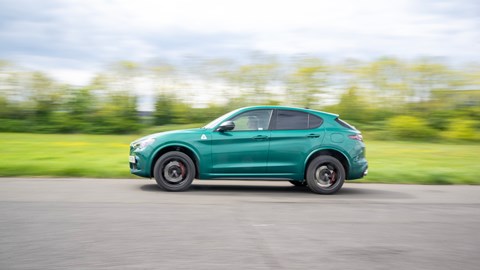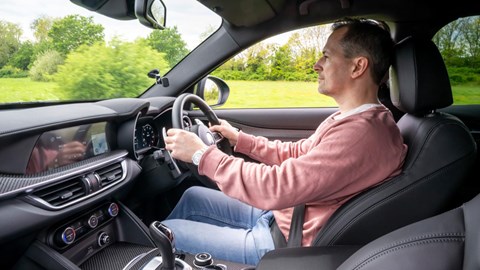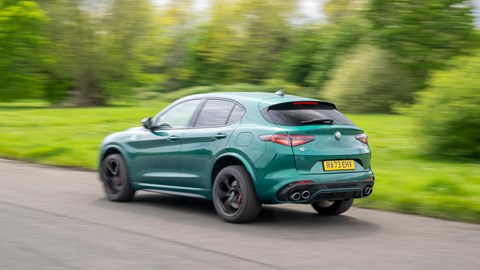► Our final verdict
► Seven months with Alfa’s top SUV
► Is it worth buying?
Unlike a lot of politicians, I don’t have to worry about people unearthing ludicrous after-hours ramblings in my ancient social media posts. But Giant Test verdicts from years back can sometimes seem just as jarring when viewed through modern eyes. As jarring as the ride on our long-term-test Stelvio Quadrifoglio, which made me wonder what I’d been smoking when I declared the pre-facelift Alfa a winner in a shootout with the Porsche Macan Turbo six years earlier.
Three days later I finally got the chance to send the Stelvio down a great road and it all came back. Even cooking Stelvios are fun to drive, thanks to their quick steering and even weight distribution. But the Quadrifoglio is something else.
It’s an animal, carving into corners like a mid-engined sports car and hurling itself out the other side and onto the next straight ready for you to grab another handful of the gorgeous metal shift paddles – which are fixed to the wheel and make using the column stalks annoyingly difficult, for an authentic Italian supercar experience.

I still think the Stelvio is sensational to drive fast, and a new differential on the rear of the facelifted car ups the joy quotient. But in six months of living with the refreshed Quadrifoglio, driving it for shopping and runs to the train station as well as driving it for fun, the opportunities to bring out the superhero side of it were too few, and the flaws in its basic make-up too hard to ignore.
Although Alfa has improved the handling (with the diff and suspension tweaks) and the styling (with LED headlights), and bumped the 2.9-litre V6’s output up 10bhp to 513bhp, those were the bits that needed the least attention. The parts that were less than stellar back in 2018, but which I was willing to overlook in exchange for then dopamine kick of great chassis dynamics, are the bits that really needed the investment.
We’ve mentioned the crude ride, but the small, fiddly infotainment system also felt disappointingly unsophisticated. It has been updated since we first drove the car before the pandemic, but it might as well be a pushbutton AM radio next to the slick curved iDrive display on BMW’s similarly priced X3M. The digital instrument pack also lacks the configurability of rivals’ systems, being unable to show a map, although the graphics take on a Lamborghini-like demeanour when you switch the driving mode dial to Race mode; fun, but not as helpful as a map.

I liked that the Stelvio still has physical rotary dials for the climate control, though I imagine they’re only there due to the age of the base car, and the black leather sports seats looked and felt great whatever the journey length. The rear seats are short on SUV-type sliding and folding versatility, but the amount of space available isn’t terrible. You could say the same for the overall quality of the cabin materials. Not bad, but rivals do it better.
I was also surprised at how rattly the bi-turbo V6 sounded at low speed, driving with the windows down revealing a pinking noise like an old car with its distributor set too advanced. The eight-speed auto’s low-speed manners weren’t great, either, and by the end of the loan the big, drilled brake discs squeaked during parking manoeuvres.
The Stelvio went back to Alfa before I had the opportunity to book in the 9000-mile service that would have given the dealer a chance to check the brakes. I called Vospers of Exeter a month before the scheduled return but was told it couldn’t get me in for six weeks. Alfa collected the car in five. It’s worth noting that Porsche Macan and Cayenne models only need servicing every two years or 20,000 miles, and don’t depreciate anywhere near as heavily.

Still, I stand by that 2018 test verdict. The Quadrifoglio was and is more exciting and more charismatic to drive, turns heads and has a real feelgood factor, and those things have always been priorities for people who buy Alfas. But it’s feeling its age in the other areas that matter when you’re living with a car day in, day out. Porsche upgraded the Macan a couple of years ago and the top-spec GTS is £15k cheaper than the QF. Beguiling as the Stelvio is, I’m not sure I’d fancy its chances of taking it in a rematch.
Logbook
Price £87,195 (£90,745 as tested)
Performance 2891cc turbocharged V6, 513bhp, 3.8sec 0-62mph, 177mph
Efficiency 23.9mpg (official), 20.2mpg (tested), 267g/km CO2
Energy cost 34.0p per mile
Miles this month 236
Total miles 9234
Count the cost
Cost new £90,745
Part exchange £48,420
Cost per mile 34.0p
Cost per mile including depreciation £4.51